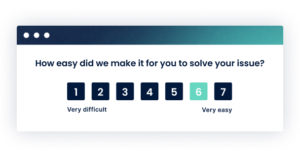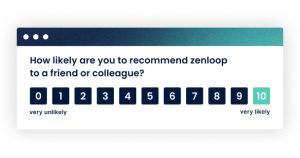Customer Satisfaction
The Be-all and End-all for Good Business
Satisfied customers are the most important prerequisite for good sales and vital for sustainable company growth.
Collection and management of customer satisfaction should therefore have a firm place in the marketing efforts of every company. Various factors play a role here and valuable insights can be gained if the right analysis tool is used.
Table of Contents
- Customer Satisfaction Factors
- Measure Customer Satisfaction
- Record Overall Satisfaction
- Determine Key Figures Before Measurement
- Step by Step to Successful Data Collection
- Getting Closer to the Customer through Satisfaction Surveys
- Learnings to Increase Customer Satisfaction
- If Something Doesn’t Work: Professional Complaint Management
Customer Satisfaction Factors
Satisfaction is an extremely subjective parameter that is influenced by many known and unknown customer factors. Basically, every action takes place with a certain expectation, be it the gathering of information, the purchase process, the use of the support or the first-time use of the product. If their expectations are met or even exceeded, the customer is satisfied and will most likely buy again and even recommend the company. However, if expectations are not met, the customer is dissatisfied. So far, so good.
However, the various factors that affect satisfaction are far more complex. On the one hand, previous buying experiences with other companies play a role, as do recommendations from friends and acquaintances. However, even more, important are the experiences that the customer has with a company. The gathering of experience begins with the first contact with a brand (e.g. through advertising) or with an online shop (e.g. with a Google search) and extends through the purchase process to the receiving and trying out of the products for the first time, and even beyond. The customer gathers impressions throughout their customer journey that have a positive or negative impact on customer satisfaction. The goal of a company should be to at least meet the expectations of its customers, or even better: to exceed them. This is exactly what ensures strong customer loyalty. In our guide to customer satisfaction, these factors are examined in more detail.
Related:
What are customer expectations? What are the factors that influence them?
Measure Customer Satisfaction
To make concrete statements about the satisfaction of your own customers, you need a definition of the key figures as well as their measurement and analysis. To ensure that surveying customer satisfaction can lead to more sales, it should be done continuously. This is the only way to derive strategies and have the efforts of marketing, sales and product development controlled and result in continuous optimization. But how can you reliably measure customer satisfaction?
Record Overall Satisfaction
The following channels can be used to get a first impression:
- Social media: what image is conveyed through comments and message requests on your own channels? How is advertising reacted to and what kind of comments does it attract?
- Review portals: here, customers often leave their opinions in detailed form. The moderation and processing of complaints here should be carried out conscientiously, in order to potentially win over dissatisfied customers.
However, these platforms are not suitable for exact satisfaction assessment, they are only useful for capturing the general mood. It is obvious that customers write reviews more often if they are very dissatisfied or extremely enthusiastic. The nuances in between can hardly be illuminated in this way. Nevertheless, observation of these channels should take place in addition to other survey methods.
Determine Key Figures Before Measurement
Metrics play a significant role when measuring customer satisfaction – as in almost all parts of the corporate strategy. With such a subjective matter as tendencies and attitudes, figures can seem complicated at first glance. With the right strategy, however, these indicators can be correctly interpreted. Using suitable KPIs, the obtained results can be simplified, condensed, and made comparable. With the help of scores or point systems, the different customer groups can be understood and categorized to improve service or marketing efforts specifically.
The targeted survey regarding product properties is invaluable for product development. The company can thus meet changing customer needs and translate their feedback into concrete improvement efforts.
Further Reading:
Step by Step to Successful Data Collection
To get the best possible results, surveying customer opinion must be well prepared and planned. First, the goals of the survey must be defined. Answering questions like these is a good start:
- What insights should be gained?
- Which customer groups should be interviewed/analyzed?
- Should participation in a survey be linked to an incentive, such as a discount?
The next steps can be derived from these basic considerations. Various methods come into play in the subsequent determination of the questions and evaluation dimensions.
Objective Methods
Analyzing the data obtained from surveys requires comparing figures. The following are proven key scores that produce comparable values:
- Customer Satisfaction Score: The CSAT provides information about the overall satisfaction of individual customers regarding a specific company interaction (for example, one could ask about satisfaction with the product or with its delivery).
- Customer Effort Score: The CES allows the assessment of how complex customers find interaction with the company (for example, a question might be aimed at the effort required to complete an order or to reach customer support).
- Net-Promoter-Score®: Der NPS ermittelt die Wahrscheinlichkeit der Weiterempfehlung und ermöglicht die Unterteilung der Kunden in diverse Kundengruppen.
- Things Gone Wrong: The TGW value shows the proportion of complaints in the total number of purchases.
- Social Sentiment: This size shows moods and tonalities in social media.



Subjective Methods
Subjective methods deal with customer opinions on the company image or the range of offers. These opinions can be gathered, for example, using the following methods:
- Questionnaires
- Personal customer surveys
- Telephone interviews
- Online surveys
Getting Closer to the Customer through Satisfaction Surveys
With customer satisfaction surveys, a company gains valuable insights into the opinions and expectations of customers and partners. The survey answers are mostly unfiltered and are given freely. Serious and open communication, in which consumers feel that their wishes are taken seriously, is essential for a good customer relationship. Only with the certainty that their own, honest opinion is important for the company will customers take the time to complete the survey – this is by no means taken for granted.
Thanks to the regular use and evaluation of customer surveys, management and marketing receive the data necessary to optimize their strategies and can thus ensure higher customer satisfaction.
Learnings to Increase Customer Satisfaction
From the data gathered by all these methods, measures can be determined to increase customer satisfaction. Where can your service or product be improved? What are recurring pain points? What do customers want beyond the existing range? Short micro surveys that can be carried out with zenloop’s Net Promoter Score, for example, are an important source of feedback. Essential for success is cross-departmental collaboration. Marketing, sales, and support are particularly important here. Goals and targets should be internally transparently communicated and evaluated. Ideally, the employees concerned undergo continuous training.
As we can see: determining and improving customer satisfaction is not a one-off effort, but an ongoing attempt to win and retain customers, continuously improve your own company, and better your products and services. This is the only way for brands to remain competitive in the rapidly changing markets. On top of this, satisfied customers are the best reference, as they make recommendations to friends and acquaintances, leave praising reviews and ensure additional sales with increasing turnover.
If Something Doesn’t Work: Professional Complaint Management
An important, often previously neglected element of customer satisfaction is complaint management. It offers lots of potentials to recapture an unsatisfied customer and their complaint through fast processing and generous handling and turn it into a positive experience – because not every dissatisfied customer leaves immediately. If an error or a malfunction is rectified professionally and correctly and in the interests of the customer, confidence in the company increases. In the end, customers are just people, and people know that mistakes can happen. How the company deals with its own omissions or product defects is the decisive factor.
Successful complaint management includes:
- Trained support staff
- Actively querying satisfaction instead of waiting passively for complaints
- Short response times including confirmation of receipt
- Accessibility on many channels
In determining customer satisfaction the Net Promoter Score (NPS®) comes into play. Instead of just guessing why bad ratings are given, the NPS enables the precise identification of weaknesses and thus enables specific measures to be remedied. It provides information about whether a customer would recommend the company and its products or services.
Satisfied customers with zenloop






